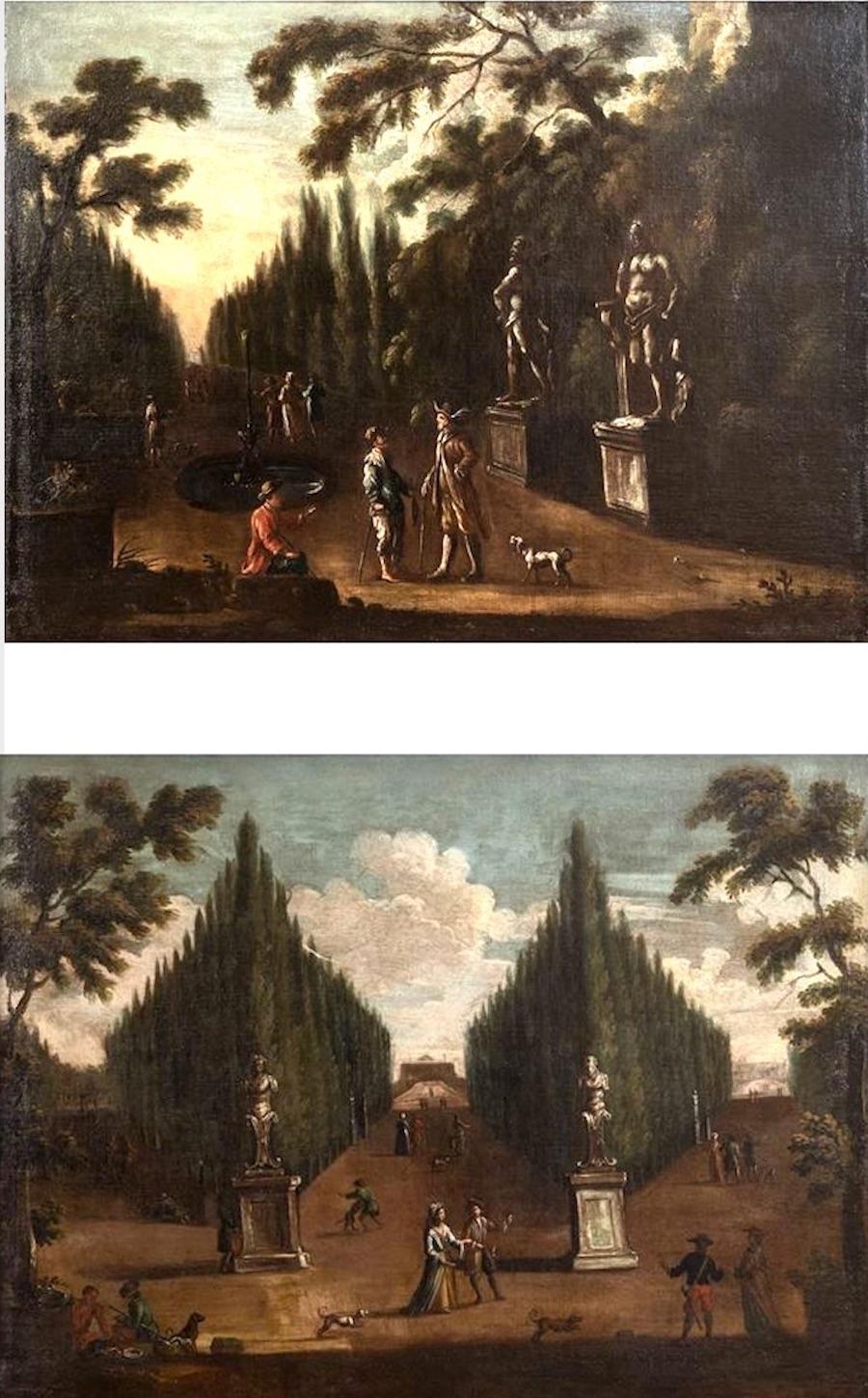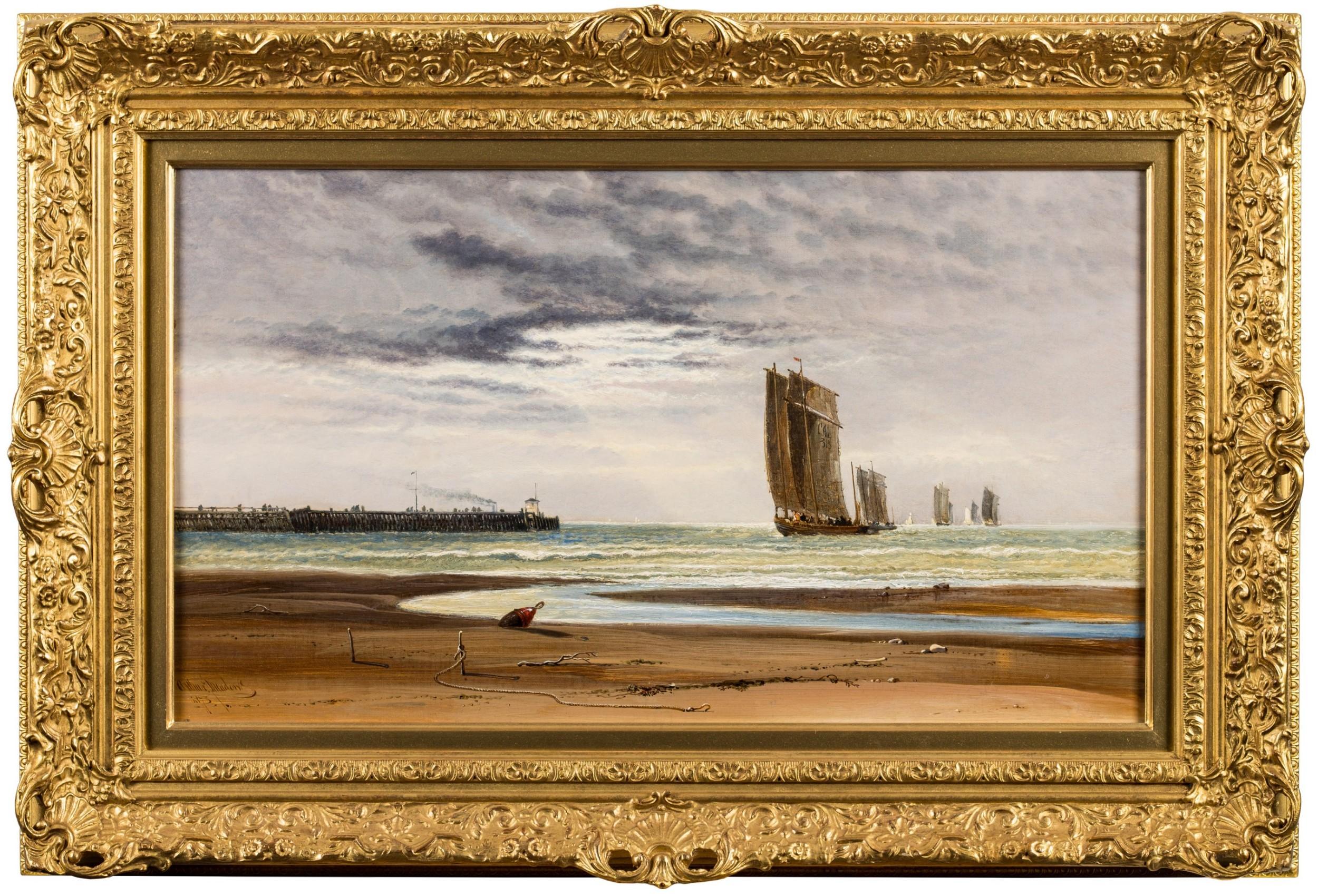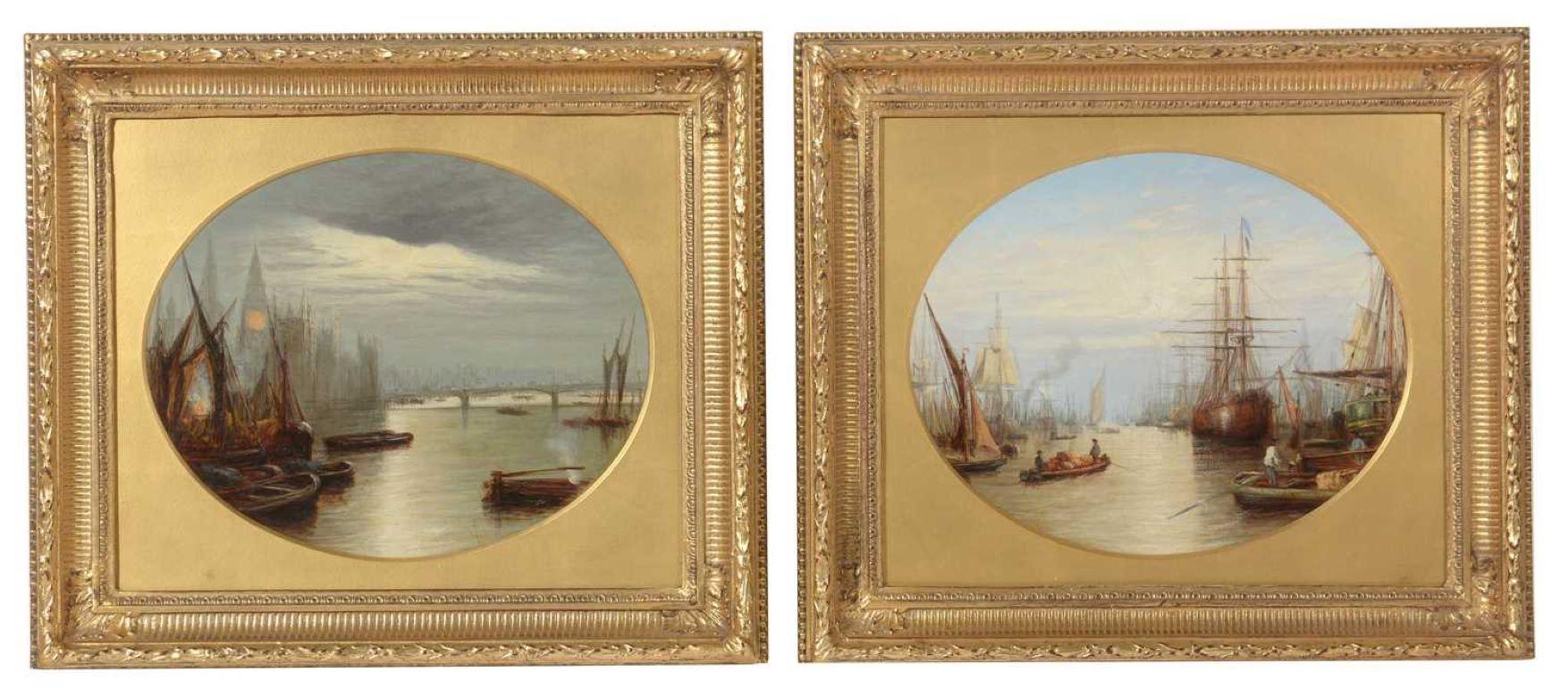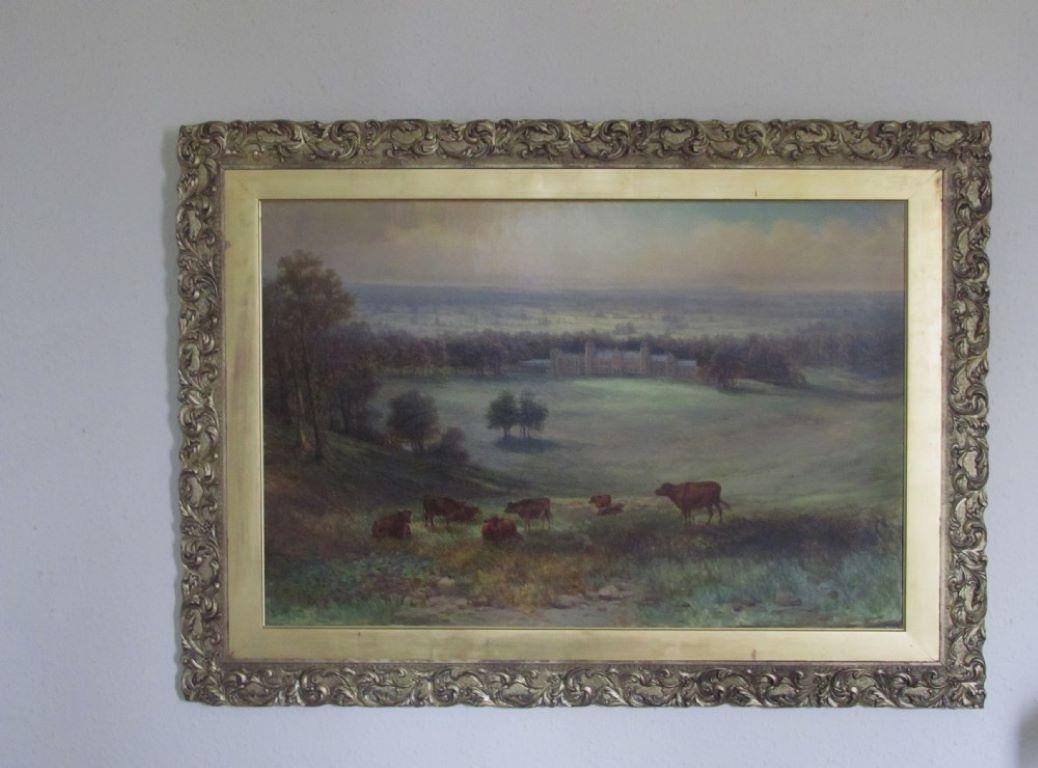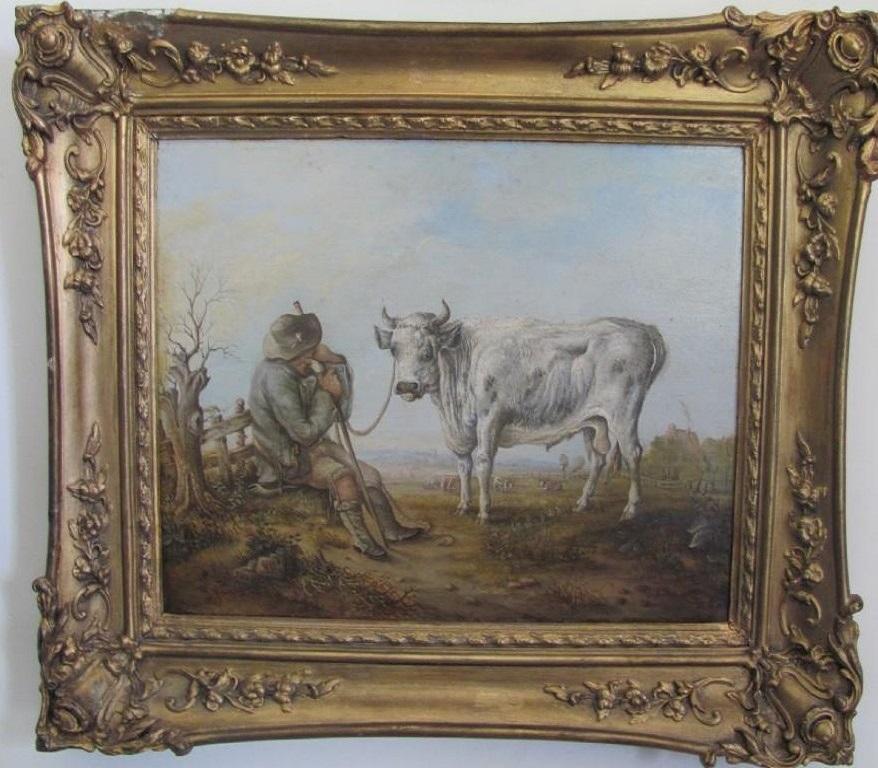Items Similar to Oil Painting of Landscape with 'The Papal Palace at Avignon'
Want more images or videos?
Request additional images or videos from the seller
1 of 12
Pieter BoutOil Painting of Landscape with 'The Papal Palace at Avignon'c.1700
c.1700
About the Item
Provenance:
Sotheby’s December 5th 2006, Lot 388
Bout was a Flemish painter, draughtsman and etcher. He is known mainly for his landscapes, city, coast and country views and architectural scenes painted in a style reminiscent of earlier Flemish masters such as Jan Brueghel the Elder.
Even while Pieter Bout was well-known in his time as demonstrated by his frequent collaborations with prominent Flemish painters and his substantial output, the details of his life are not very well established. He was probably born in Brussels somewhere between 1640 and 1658. It is not known with whom he studied. He became a master in the Brussels Guild of Saint Luke in 1671 but his earliest work is dated 1664 and therefore predates his enrolment in the Guild. He got married on 30 November 1667 in Brussels
- Creator:Pieter Bout (1658 - 1719, Flemish)
- Creation Year:c.1700
- Dimensions:Height: 22.5 in (57.15 cm)Width: 26.5 in (67.31 cm)
- Medium:
- Movement & Style:
- Period:
- Condition:
- Gallery Location:London, GB
- Reference Number:1stDibs: LU67334123912
About the Seller
5.0
Vetted Seller
These experienced sellers undergo a comprehensive evaluation by our team of in-house experts.
Established in 1990
1stDibs seller since 2017
40 sales on 1stDibs
Typical response time: <1 hour
- ShippingRetrieving quote...Ships From: London, United Kingdom
- Return PolicyA return for this item may be initiated within 1 day of delivery.
More From This SellerView All
- Grand 19th Century English Marine Painting in Stunning LightBy John Wilson EwbankLocated in London, GBJohn Wilson Ewbank (1799 - 1847) Shipping in the Harbour, South Shields Oil on canvas 39.5 x 58 inches unframed 47.75 x 66.5 inches framed Provenance: Christie's October 2002; Lot 11. Fine Art Society; Private Collection This marvellous up to scale Ewbank is full of light and warmth and almost certainly his greatest work of the sort rarely - if ever - seen on the market. John W. Ewbank (4 May 1799–28 November 1847), was an English-born landscape and marine painter largely operational from Scotland. The Humber river is a large tidal estuary on the east coast of Northern England. Life Ewbank was born at Darlington on 4 May 1799, the son of Michael Ewbank, an innkeeper. He was adopted as a child by a wealthy uncle who lived at Wycliffe, on the banks of the River Tees, in the North Riding of Yorkshire. Intended for the Roman Catholic priesthood, he was sent to Ushaw College, from which he absconded. In 1813 Ewbank was apprenticed to Thomas Coulson, an ornamental painter in Newcastle. In around 1816 he moved with Coulson to Edinburgh, where he had some lessons with Alexander Nasmyth. He found work both as a painter and a teacher. He was nominated in 1830 one of the foundation members of the Royal Scottish Academy. In 1833 he is listed as living at 7 Union Street on the eastern fringe of the New Town in Edinburgh. Works His sketches from nature were especially admired, and a series of 51 drawings of Edinburgh by him were engraved by W. H. Lizars for James Browne's Picturesque Views of Edinburgh (1825). He also made a reputation with cabinet pictures of banks of rivers, coast scenes, and marine subjects. As an illustrator he illustrated some early editions of Scott's Waverley Novels and one edition of Gilbert White...Category
19th Century Old Masters Figurative Paintings
MaterialsOil
- 18th Century English Oil Landscape Painting: Elegant Figures alongside River WyeBy Attributed to William MarlowLocated in London, GBAttributed to William Marlow (English, 1740-1813) Elegant Figures alongside the River Wye 1790 131 x 152 cm, inc. frame This quiet bucolic scene shows figur...Category
Late 18th Century Old Masters Figurative Paintings
MaterialsCanvas, Oil
- Monumental 17th Century Landscape Painting with Figures in an Arcadian settingLocated in London, GBEnormous 17th Century Italian landscape with figures in Arcadia. Unframed at present. Excellent condition.Category
17th Century Old Masters Landscape Paintings
MaterialsOil
- 19th Century French Oil Painting Algeria - Capture of the Smalah of Abd el KaderBy Émile Jean-Horace VernetLocated in London, GBCircle of Emile Jean Horace Vernet (1789-1863) The Capture of the Smalah of Abd el Kader oil on canvas 48 x 55 1/2 in; 121 x 141 cms (including magnificent contemporary carved frame) Provenance Private collection, United States This important and impressive work records the historic skirmish in 1843 between a cavalry unit lead by the duc de Aumale and the Arab chief Abd el Kader during the French military campaign in Algeria. The painting is attributed to Horace Vernet, and relates closely to a major work of the same subject by Vernet now in the Musée de l'Histoire de France in Versailles. The work is a classic example of French Orientalist painting...Category
Mid-19th Century Old Masters Figurative Paintings
MaterialsOil
- 18th Century Neoclassical Oil Painting of the Trojan War: Briseis & AchillesBy James ThornhillLocated in London, GBJames Thornhill (1674-1735) Oil on canvas 12 x 14 inches; 16 ½ x 18 ½ in. Inc. frame The subject matter and inclusion of herms on both sides shows the influence of Louis...Category
Early 18th Century Old Masters Figurative Paintings
MaterialsOil, Canvas
- 18th Century Lanscape Oil Painting of Matlock High-TorrBy Thomas Smith (b.1720)Located in London, GBThomas Smith of Derby Matlock High-Torr Landscape Oil on canvas 27 x 34.5 inches unframed 34 x 41.5 inches including frame Thomas Smith of Derby (died 12 September 1767) was an Engl...Category
18th Century Old Masters Landscape Paintings
MaterialsOil
You May Also Like
- Pair of Italian 18' century Paintings with GardensLocated in Rome, ITPair of Italian 18' century paintings , oil on canvas with Venetian Palace gardens , antiques sculptures and various figures . Measurements with f...Category
Mid-18th Century Old Masters Landscape Paintings
MaterialsOil
- Italian Landscape with Jack Players, a painting by Gaspard Dughet (1615 - 1675)By Gaspard DughetLocated in PARIS, FRHere Gaspard Dughet offers us an idyllic vision of the Roman countryside. The stages follow one another in a perfectly structured composition, revealing here a lake, there travellers walking along, gradually leading our eye to the blue horizon. But behind its classical composition, this landscape is particularly interesting because of three anthropomorphic details that the artist has hidden, opening the way to a radically different interpretation... 1. Gaspard Dughet, a landscape artist in the light of Poussin Gaspard Dughet was born on June 4th, 1615 in Rome where his father, of French origin, was a pastry cook. He was probably named Gaspard in honour of his godfather Baron Gaspard de Morant, who was, or may have been, his father's employer. His older sister Jeanne married the painter Nicolas Poussin (1594 - 1655) on September 1st, 1630. The young Gaspard was apprenticed with his brother-in-law at the beginning of 1631, which led his entourage to name him Gaspard Poussin. The first preserved works of the painter date from the years 1633-1634 and were painted in Poussin’s studio. Around 1635, Gaspard Dughet became emancipated and began to frequent the Bamboccianti circle. In 1636, he became friends with the painter Jean Miel (1599 - 1656), but also with Pier Francesco Mola (1612 - 1666) and Pietro da Cortona (1596 - 1669). This was also the time of his first trips throughout Italy. The painter, although of French origin, appears never to have visited France. In 1646 he settled permanently in Rome. A recognized painter with a solid book of orders, he remained faithful to landscape painting throughout his life, alternating between cabinet paintings and large decorative commissions, using both oil and fresco. Nailed to his bed by rheumatic fever at the age of 58, he died on May 25, 1675. 2. Discovering an idealized landscape Beyond a relatively dark foreground that takes us into the landscape, we discover a vast bluish horizon: a plateau surrounded by deep ravines advances to the right, overhanging an expanse of water that sparkles below. A road winds through a mountainous mass as if leading us to the fortress that crowns it; another town appears in the distance at the foot of three conical mountains. The composition is rigorous, mineral, and structured by geometric volumes. The various stages in the landscape lead one to the next attracting the eye towards the horizon located in the middle of the canvas. The general impression is that of a welcoming and serene nature. In many places the paint layer has shrunk, or become transparent, revealing the dark red preparation with which the canvas was covered and accentuating the contrasts. Human presence is limited to three jack players, leaning against a mound in the foreground. Their long garments, which may evoke Roman togas, contribute to the timelessness of the scene. Close examination of the canvas reveals two other travellers on the path winding between the rocks. Made tiny by the distance, their introduction in the middle register, typical of Dughet's art, lengthens the perspective. While it is difficult to date the work of a painter who devoted his entire life to the representation of landscapes, it is certain that this painting is a work from his later years. The trees that occupied the foreground of his youthful compositions have been relegated to the sides, a stretch of water separates us from the arid mountains counterbalanced by two trees represented on the opposite bank. The introduction of this stretch of water in the middle of the landscape betrays the influence of the Bolognese and in particular of the Dominiquin (1581 - 1641) A number of similarities with a drawing in the British Museum might suggest a date around 1656-1657, since, according to Marie-Nicole Boisclair , it has been compared with the Prado's Landscape with the Repentant Magdalene, painted at that period. 3. Three amazing anthropomorphic details While some late Renaissance landscapes offer a radical double reading, allowing one to see both a face or a human body behind the representation of a landscape, it seems interesting to us to hypothesize that Gaspard Dughet had fun here by slipping in a few details that, taken in isolation, evoke human or animal figures. We will give three examples, looking closely at a cloud, the trunk of a broken tree and the top of a cliff. The main cloud could thus evoke a Christ-like face or that of an antique god...Category
1650s Old Masters Landscape Paintings
MaterialsOil
- Arthur Joseph Meadows 19th Century Seascape Off CalaisBy Arthur Joseph MeadowsLocated in York, GBA very fine painting by the renowned seascape painter Arthur Joseph Meadows,Off Calais; fishing fleet returning at low tide. Housed in an antique style gilt frame the size overall is...Category
19th Century Old Masters Landscape Paintings
MaterialsOil
- 19th century oil, view London, the Thames, houses parliament, Francis MaltinoLocated in York, GBA fine pair of oil paintings, oil on board depicting views of the Thames one showing houses of parliament the other barges in busy shipping lane. Framed and Glazed the size being 26 ...Category
19th Century Old Masters Landscape Paintings
MaterialsOil
- 19th Century, Victorian, landscape , cows , Country House Samuel Lawson BoothLocated in York, GBS Lawson Booth : Country House in extensive landscape with cattle in the foreground, oil on canvas signed and dated '98, 60cm x 90cm (35x23 inches approx image) size with frame appro...Category
19th Century Old Masters Landscape Paintings
MaterialsOil
- 19th Century Oil Farmer And Bull Country Landscape Scene After Aelbert CuypBy Aelbert CuypLocated in York, GBAfter Aelbert Cuyp (unsigned) an oil on board country scene depicting a farmer and bull. The painting is in overall very good condition however the frame has some losses .Mainly to...Category
19th Century Old Masters Landscape Paintings
MaterialsOil
Recently Viewed
View AllMore Ways To Browse
Flemish Landscape Painting
The Antique Guild
Flemish Landscape Oil Painting
Saint Paintings 18th Century
18th Century Saint Painting
Avignon Antique
Flemish 18th Century Oil Painting
Brueghel Painting
Saint Luke
Happy Face
Italian Old Masters Landscape Painting
Snow Mountain Art
Jardin Art
1940s Painting House
J Class
Antique Ship Oil Painting
Antique Oil Painting Ship
California Ocean Painting
